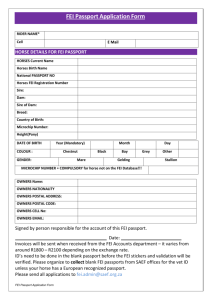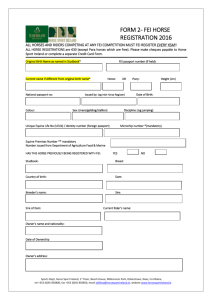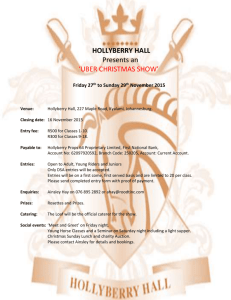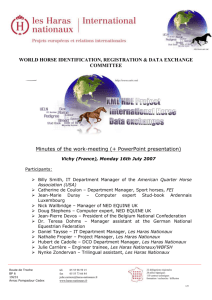Minutes_of_the_Whirdec_meeting_in_Lausanne_11122006
advertisement
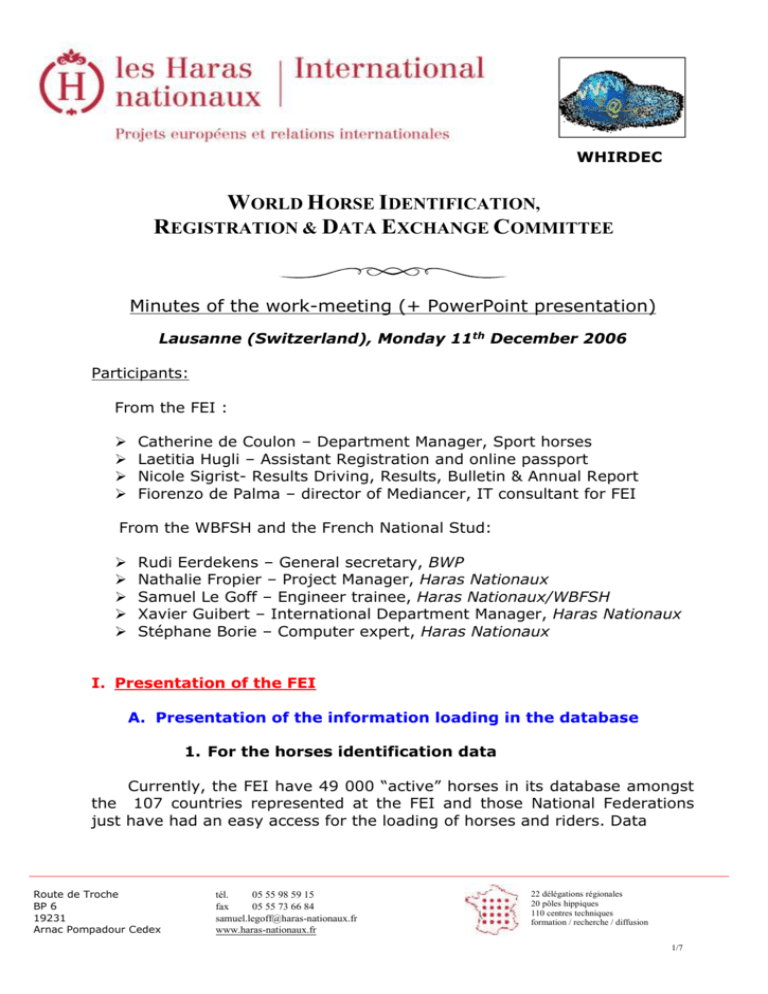
WHIRDEC WORLD HORSE IDENTIFICATION, REGISTRATION & DATA EXCHANGE COMMITTEE Minutes of the work-meeting (+ PowerPoint presentation) Lausanne (Switzerland), Monday 11th December 2006 Participants: From the FEI : Catherine de Coulon – Department Manager, Sport horses Laetitia Hugli – Assistant Registration and online passport Nicole Sigrist- Results Driving, Results, Bulletin & Annual Report Fiorenzo de Palma – director of Mediancer, IT consultant for FEI From the WBFSH and the French National Stud: Rudi Eerdekens – General secretary, BWP Nathalie Fropier – Project Manager, Haras Nationaux Samuel Le Goff – Engineer trainee, Haras Nationaux/WBFSH Xavier Guibert – International Department Manager, Haras Nationaux Stéphane Borie – Computer expert, Haras Nationaux I. Presentation of the FEI A. Presentation of the information loading in the database 1. For the horses identification data Currently, the FEI have 49 000 “active” horses in its database amongst the 107 countries represented at the FEI and those National Federations just have had an easy access for the loading of horses and riders. Data Route de Troche BP 6 19231 Arnac Pompadour Cedex tél. 05 55 98 59 15 fax 05 55 73 66 84 samuel.legoff@haras-nationaux.fr www.haras-nationaux.fr 22 délégations régionales 20 pôles hippiques 110 centres techniques formation / recherche / diffusion 1/7 WHIRDEC concerning horses, performances, riders, etc…can be seen on the FEI web site: www.fei.ch For loading a horse, all the fields have to be fulfilled correctly and it appears that in some cases, mistakes are done regarding UELN and other registration numbers. The FEI deliver passport including translation in English, French and Spanish. For example, we discussed about a German horse registered in Slovenia, the UELN of which has been put in its national number box, but it has no number in the UELN box. It is a good point that the Slovenian federation uses the UELN as an identification number, but the FEI would like those data to be fulfilled correctly in order to have a real idea of the UELN identified horses. So it seems that some countries make confusion about the UELN and the other registration numbers. This aspect might be clarified thanks to the different contacts and meetings about horse identification and registration. Another case is the problem for the commercial name or the sponsor field. In fact, one KWPN horse (registered in France as well when it was imported) is called Rolex, indeed very confusing for a database to distinguish whether it is the original name or the sponsor name. Stud-books in charge of attributing names to their horses should try to avoid as much as possible to use ambiguous name. Also a similar problem exists, especially for the French horses of the Haras Nationaux. Indeed, the FEI usually put the sponsor name in another box but for horses like Flipper d’elle*HN, it was difficult to consider if “HN” is a sponsor. An explanation has been made by Xavier Guibert and the FEI must consider every name located after the “*” as a sponsor. The FFE (French Federation) will have to separate the 2 fields while registering horses at the FEI Route de Troche BP 6 19231 Arnac Pompadour Cedex tél. 05 55 98 59 15 fax 05 55 73 66 84 samuel.legoff@haras-nationaux.fr www.haras-nationaux.fr 22 délégations régionales 20 pôles hippiques 110 centres techniques formation / recherche / diffusion 2/7 WHIRDEC 2. For the performances of a horse Concerning the performances of the horses, the events included in the rankings and the results historic for horses and riders are only for the Grand Prix, championships and events with a prize-money above 20000€. 3. For the people information The people data are fulfilled in the same page as the horse identification. Information about breeder and owner are needed. B. The controls made inside the database 1. Issuing FEI passports The FEI passport is valid for 4 years (price around 100€) When a national federation wants to load a horse, the FEI passport number starts with the FEI code of the country which first asked the FEI (e.g.: BEL, FRA,…). After, the national federations can ask for changes if a horse is exported. The FEI sends a mail to the previous federation that registered the horse and the FEI must have its agreement for making the changes, but the passport number must remain the same . For being inserted in a “recognition card”, The original passport issued by the stud-books should have a minimum of lines for each chapter : Owners = 9 places Identity control = 118 lines Medication = 33 lines Equine Influenza vaccination = 46 lines Other vaccines = 24 lines Laboratory health test = 26 lines 2. Duplicated FEI passports Route de Troche BP 6 19231 Arnac Pompadour Cedex tél. 05 55 98 59 15 fax 05 55 73 66 84 samuel.legoff@haras-nationaux.fr www.haras-nationaux.fr 22 délégations régionales 20 pôles hippiques 110 centres techniques formation / recherche / diffusion 3/7 WHIRDEC If a FEI passport is lost or full, then at this moment, the FEI makes a new passport but it would like to be able to add pages (in case of original passport issued by a stud book, the duplicate must be asked to this stud book, and a new recognition card will be given by the NF) . In case of changes, the FEI gives additional stickers. C. FEI projects and evolution Current modifications The FEI would like to implement a system which would permit to enter information automatically only by giving the UELN of the horse. Then it will be much faster and secure for the national federations. The FEI, from the UELN will ask for horse’s information from the concerned database. Also, the FEI is going to add to the present competition criteria the height of the fences and the article of regulations. Future projects Moreover, the FEI intends to promote a standard registration system similar to the FEI database for every national federations in order to harmonize the registration fields. Another project is to give the opportunity to the federations and show organizers to make their own entry lists thanks to the FEI database (name of the horses/riders and other useful information). Then, in return, the FEI would ask directly the show organizers for the results, through its web service. The FEI platform will develop SOAP protocols for sharing the data. SOAP (originally Simple Object Access Protocol) is a protocol for exchanging XML-based messages over computer network, normally using . SOAP forms the foundation layer of the Web services stack, providing a basic messaging framework that more abstract layers can build on. II. Data exchanges with FEI Route de Troche BP 6 19231 Arnac Pompadour Cedex tél. 05 55 98 59 15 fax 05 55 73 66 84 samuel.legoff@haras-nationaux.fr www.haras-nationaux.fr 22 délégations régionales 20 pôles hippiques 110 centres techniques formation / recherche / diffusion 4/7 WHIRDEC Currently, amongst 49 000 horses registered in the FEI database, 4000 have a UELN. 3400 horses less than 7 years old have a UELN. The FEI will propose Web Services (SOAP) containing all the information included in the XMLHDE. This system will be ready and operational in the beginning of 2007 and France is going to test it. That will be another partnership showing the need to exchange data via XML. III. Evolution of the XML HDE application A. Next improvements One of the next steps in the XML HDE application is to have the possibility on the UELN website www.ueln.net to search for a horse by its FEI number. At the moment, all the horses registered in the database (even those with a UELN starting with 999999) are on the XML HDE application but “selection” will be done soon in order to permit downloading only for those having a “complete” and known UELN, corresponding to this database. It will help us to continue on a good basis. Both FEI and other participants of the meeting agreed on the establishment of an historic recording all the exchanges through the XML HDE application. B. The appellation breed/stud-book/section… It is useful to give a clear definition to each appellation in order to avoid any confusion. At the next WHIRDEC meeting, we will discuss about it and clarify this table. Moreover, the FEI would like to have a common table of the stud-books and breeds with the respective abbreviations with the WBFSH. Route de Troche BP 6 19231 Arnac Pompadour Cedex tél. 05 55 98 59 15 fax 05 55 73 66 84 samuel.legoff@haras-nationaux.fr www.haras-nationaux.fr 22 délégations régionales 20 pôles hippiques 110 centres techniques formation / recherche / diffusion 5/7 WHIRDEC C. The user charter (draft to be improved and completed) Usually the FEI does not modify the information given by the national federations or stud-books, except when the WBFSH ask for specific changes. So, one of the main principles of the user charter for the XML HDE application is not to use the exchanged data in a commercial way. Another point is that each database will have the right to authorize a list of member databases to access its own database. This will work thanks to the attribution of login and password which will automatically give the list of databases available for any user database. The national federations do not manage the horses data but only the riders data and the competition results. The stud-books own the horses data. IV. The module “international performances”. For searching performances of a horse, we obtain a list of results classified by as below: Research by horse: Date - event – competition - rider - rank - Qual. By clicking on the event date, it appears some more information: Event Date: Rider: Event number: Rider FEI Registration N°: Place: First round Second round Points: points: Time: Time: By clicking on the competition name (GP, speed or final, etc…), it obtains the final ranking of the competition. Finally, if we click on the rider’s name we can see all its results of the year with its different horses. V. Next steps Route de Troche BP 6 19231 Arnac Pompadour Cedex tél. 05 55 98 59 15 fax 05 55 73 66 84 samuel.legoff@haras-nationaux.fr www.haras-nationaux.fr 22 délégations régionales 20 pôles hippiques 110 centres techniques formation / recherche / diffusion 6/7 A. After Lausanne WHIRDEC The module “international performances” is going to be developed based on the FEI model. For this module, a web service permitting an update of the results will be implemented between the FEI database and the UELN web site. For the next General Assembly of the WBFSH, Catherine de Coulon, Coordinator of the General Information System at the FEI and currently member of the WHIRDEC, will make a presentation of the FEI way of registering and maintaining horses data and performances. B. Meeting in Brussels ( 24th of January ?) For this meeting, the following topics will be discussed : The table of coats : make a standard table which could be understandable by any organisation in any country. Same work on the table of sexes Definition and classification of the different titles : database, studbooks, breeds, appellation Also clarify the appellation pony/horse Route de Troche BP 6 19231 Arnac Pompadour Cedex tél. 05 55 98 59 15 fax 05 55 73 66 84 samuel.legoff@haras-nationaux.fr www.haras-nationaux.fr 22 délégations régionales 20 pôles hippiques 110 centres techniques formation / recherche / diffusion 7/7
